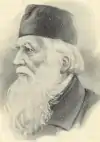William Davies Evans
Captain William Davies Evans (27 January 1790 – 3 August 1872) was a seafarer and inventor, though he is best known today as a chess player. He is buried at the Belgian port of Ostend.

Early life
Evans was born at St Dogwells, Pembrokeshire, Wales. It is almost certain that young Evans went to Haverfordwest Grammar School, the only school of any antiquity in Pembrokeshire. About the beginning of the century the family moved to Castle Pill, the name of an inlet of Milford Haven on the north side, just east of Milford town. By 1818, he had learnt the moves of chess.
Early career
At the age of 14, (in 1804) Evans went out to sea to serve in the navy until 1815, when the war ended. He was then transferred to the postal department; by 1819, he had reached the title of Captain of the sailing packet.
Around 1825–1826, on shore leave in London, Evans played Alexander McDonnell, beating the latter with what is now regarded in chess circles as the first creation of the Evans Gambit (1.e4 e5 2.Nf3 Nc6 3.Bc4 Bc5 4.b4).[1]
Inventions
Evans is known for inventing tri-coloured lighting on naval vessels designed to prevent collisions at night. For this invention he was awarded £1500 by the British government and a gold chronometer and £200 from the Tsar of Russia.[2]
References
- William Davies Evans player profile and games at Chessgames.com
- An article about Evans, chesscafe.com
- Tim Harding, ‘Evans, William Davies (1790–1872)’, Oxford Dictionary of National Biography, Oxford University Press, May 2012
- The Welsh Academy Encyclopaedia of Wales. John Davies, Nigel Jenkins, Menna Baines and Peredur Lynch (2008) pg274 ISBN 978-0-7083-1953-6